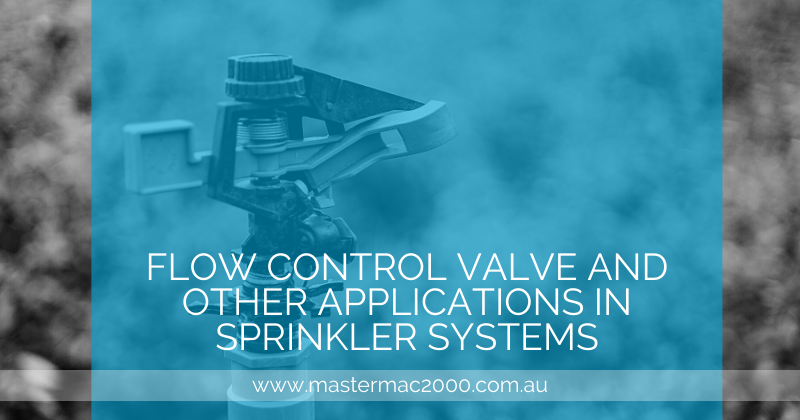Flow Control Valve and Other Applications in Sprinkler Systems

Big or small, sprinkler systems either for gardens or irrigation can be a bit confusing when it comes to maintenance. Whether you’re locating a flow control valve, understanding what the wires are for, or trying to analyse the controller, you need to understand all the necessary components of a typical lawn sprinkler system that is run using city water.
Backflow Preventer
For basic sprinkler systems, the water is distributed only in one direction. This flow is from the city to your house. To prevent an accidental water flow reversal, a directional backflow preventer is in place to prevent contaminated water from travelling in the other direction towards the city’s water supply. The backflow is turned on during the spring when you start watering the lawn, and is subsequently turned off in the fall when no lawn watering is done during the cold months.
Sprinkler Valve Box
This is where the flow control valve and manifold are found. Some valves can also be found above ground. Valve boxes are usually around the perimeter of your house. It’s not that hard to find.
Manifold
The manifold distributes water to your valves. All manifolds are individually connected. The manifold is usually the white or large tube that branches off from the long singular pipe.
Pump Control Valve
The pump valve – also called a flow control valve – will automatically regulate the start-up and shutdown of water flow to minimise any hydraulic system surges.
Master Valve
The master valve is the electric valve installed with the main water supply for the sprinkler or irrigation system (For irrigation systems, the master valve is quite large and located above ground. For sprinklers, it’s a small box just beside the valve box). A master valve reduces any water loss because of a leaky station valve, and this, in turn, can only leak while the master valve is providing pressure to the system. Should the main water line become damaged, the master valve can control water loss so the main can be repaired without the water supply being shut down.
Electric Solenoid Valves
These valves are powered by 24 volts from the controller. When the controller turns a valve on, it sends 24VAC to the solenoid. Solenoid valves always have two wires. The “hot wire” is connected to the controller and receives the 24 volts. The “common wire” is connected to all the valves and sprinklers in the lawn.
Master Mac 2000
Master Mac 2000 is the flow control valve, pneumatic tools, and process equipment specialists in Australia since 1989. It is now one of Australia’s largest distributors. Call our helpful sales staff every 7:30-5:00 PM, Monday to Friday, for all your pneumatic equipment needs, big or small, personal or industrial. Visit the Master Mac 2000 website at https://mastermac2000.com.au/.

About MasterMac2000: Your Trusted Pneumatic & Process Automation Partner.
LEADING THE INDUSTRY: Established in 1989, MasterMac2000 has grown to become one of Australia's largest privately owned pneumatic and process automation companies. We stock top-quality brands like Univer, Mack, Tolomatic, Mac, Piab, American, and Rotoflux in Brisbane.
SERVING QLD & NORTHERN NSW: We proudly service Queensland and Northern New South Wales for all your pneumatic and process equipment needs. Our mission is to provide the best pre and post-sales support while actively expanding our client base.
SOURCING HARD-TO-FIND PARTS: Not only do we stock quality components, but we also excel at sourcing those elusive, hard-to-find parts. With our extensive database and global network of contacts, getting the parts you require is as easy as a call to our highly skilled, professional sales team.
DEDICATED TO YOUR SUCCESS:
- Decades of expertise in pneumatics & process automation
- Carefully curated selection of world-class brands
- Exceptional sourcing capabilities for speciality parts
- Knowledgeable sales staff dedicated to finding solutions
- Unwavering commitment to customer service excellence
About The Author
Stuart Havill
Stuart Havill is the owner and manager of MasterMac2000, Queensland's largest privately owned pneumatic and process valve company.
With his early working career as a maintenance fitter for Boral in 1992, Stuart has spent his life in the field of pneumatics and process equipment. He gained extensive experience in plant design, maintenance, repairs, fabrication, and site management.
In 1996, he transitioned to a pneumatic sales technician role at MasterMac2000, where he excelled in key account management, providing cost-effective solutions, and managing a sales team of 9 employees.
Since 2002, Stuart has been the manager at MasterMac2000, overseeing the company's growth and establishing it as a leader in pneumatic automation and process valve engineering. His expertise spans customer training, CRM setup, industrial compressor sizing and installation, and turn-key project management.
Under Stuart's leadership, MasterMac2000 has been servicing the industry since 1988, with 5 full-time sales representatives covering northern rivers NSW, Queensland, Northern Territory, and PNG. The company prides itself on providing the best-priced solutions to all customers in the marketplace.
View Stuart’s LinkedIn profile to learn more about his expertise in pneumatics and process equipment.